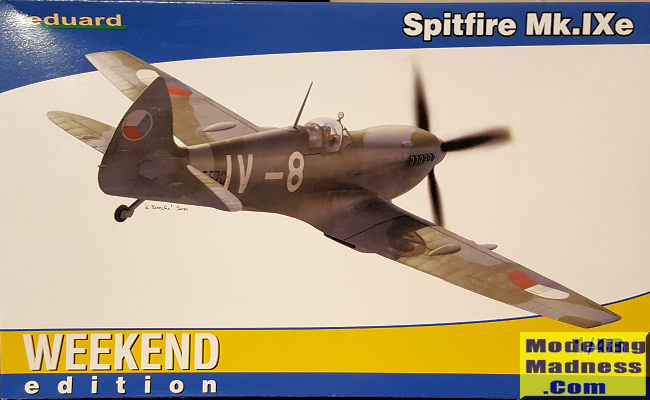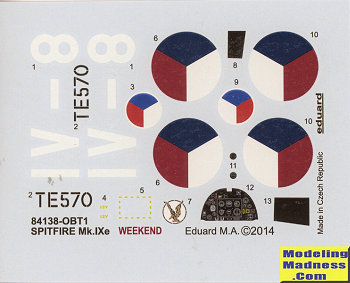
| KIT #: | 84138 |
| PRICE: | ~$25.00 street price |
| DECALS: | One option |
| REVIEWER: | Scott Van Aken |
| NOTES: | 2014 Weekend Edition |

| HISTORY |
In the early months of 1942, with the clear superiority of the Focke-Wulf Fw 190 over the Spitfire VB, there was much pressure to get Spitfires into production using the new two-stage supercharged Merlin 61 engine. In September 1941 the Spitfire Mk III prototype N3297 had been converted by Rolls-Royce at their Hucknall plant to take a Merlin 60, which had been specifically designed for use in the Wellington Mk VI high altitude bomber.
The performance increase was described by Jeffrey Quill as a "quantum leap" over that of the Mk VB and another Spitfire airframe, R6700 was modified to take the new engine. Although design work on the Mk VII and VIII series was under way, these would take over a year to get into production and a counter to the Fw 190 was urgently needed. The Air Ministry made the decision that Mk VC airframes should be converted to take the more powerful engine and, as a result, many of the early IXs were converted Mk VCs which did not have any of the refinements which later appeared. These could be identified by the Type C wing with the large double blisters over the inner cannon bays and the identification light on the fuselage spine, behind the aerial mast. The elevator horns were also smaller in size than that of most Mk IXs which had larger horn balances. The first IX was a modified VC AB505, which was tested by the Air Fighting Development Unit (AFDU) in April 1942. The report said;
Although the Mk IX's airframe did not have the aerodynamic and strength improvements, or the modified control surfaces of the Mk VII and VIII, the Mk IX still proved to be an effective counter to the Focke-Wulf Fw 190. In September 1942, the "High Altitude Flight" was set up at RAF Northolt to counter the threat of the high altitude Junkers Ju 86 R bombers. Two Spitfire IXs converted from VCs were stripped of armour, the .303 Brownings and other equipment and repainted in a lightweight PRU blue finish. One of them intercepted a Ju 86R at over 40,000 feet (12,000 m).
Production of the Mk IX finished at Supermarine in June 1943, with production continuing exclusively at the Castle Bromwich factory. Several major and large numbers of minor improvements were progressively introduced to Mk IXs, some of which were used on other Spitfire variants.
The Merlin 61 was phased out early in 1943 in favour of the Merlin 63 and 63A. The new engine had increased power resulting from engine improvements and engine limitations of +18 lbf/(sq in) and 3,000 rpm (5 minute combat). During the second half of 1943, production of the Merlin 63 powered F Mk IX was discontinued in favour of the Merlin 66 powered LF Mk IX. Early production Spitfire IXs suffered from vapour locks in the fuel lines resulting from fuel evaporating if the aircraft was parked in direct sunlight. As a result of this the gun-camera was moved from the port wingroot to the starboard wingroot and a fuel cooler, fed by a small round air-intake was fitted in its place. This fuel cooler was also fitted to early PR Mk XIs.
Production of the LF Mk IXs, frequently referred to as the Spitfire IXB, initially ran in parallel with the Merlin 63 powered Marks. This version first became operational in March 1943 with the Biggin Hill Wing, comprised at the time of 611 and 341 (Free French) Squadrons. This type was by far the most produced of the Spitfire IX variants, with over 4,000 built. The maximum power of the Merlin 66 was 1,720 hp (1,280 kW) at 5,750 ft (1,283 kW at 1,752 m) and the maximum speed of the Spitfire LF IX was 404 mph (650 km/h) at 21,000 feet (6,400 m). The Merlin 66 introduced a new Bendix-Stromberg injection carburettor, which replaced the earlier S.U float carburettor.
The H.F IX was powered by the specialised high altitude Merlin 70 and entered service in the Spring of 1944. Serial listings show that the HF Mk IX was produced in relatively limited numbers when they were required, with priority being given to versions rated for low and medium altitudes Maximum power of the Merlin 70 was 1,710 hp (1,280 kW) at 11,000 ft (1,275 kW at 3,353 m): maximum speed of the Spitfire HF.IX was 405 mph (652 km/h) at 25,400 feet (7,700 m) at an all-up weight of 7,320 lb (3,320 kg).
Also introduced in early 1944 was a new Mark II Gyro gunsight. This gunsight calculated the correct angle of deflection to use when leading the target. Its introduction doubled the effectiveness of RAF gunnery and was a major factor in Allied air superiority. Many late build Mk.IXs with the E wing were used post war by a number of foreign air arms.
| THE KIT |
 Eduard
is apparently on a campaign to produce kits of all the different variants of
the Spitfire as it can. At least those powered by Merlin engines. This makes
sense as there are quite a few interchangeable parts amongst the various
marks. They started with the later Spitfire VIII, IX, and XVI as those all
share quite a bit of commonality.
Eduard
is apparently on a campaign to produce kits of all the different variants of
the Spitfire as it can. At least those powered by Merlin engines. This makes
sense as there are quite a few interchangeable parts amongst the various
marks. They started with the later Spitfire VIII, IX, and XVI as those all
share quite a bit of commonality.
One of the major issues that modelers have with Eduard is that their kits are fussy to build. This is probably due to the large number of parts and the tendency to model something with two or three parts where a single piece would be just as good. This has been continued with this kit where the upper cowling piece is two parts instead of just one. Same for the lower cowling and wheel wells where each well is seven parts.
The cockpit is very nicely done with lots of detail, and that includes the sidewalls. As this is the weekend edition, there are no photo etch parts so you are provided a decal for instruments. You'll also have to source the seat harness from somewhere else. Note that the instructions don't tell you to apply the instrument decal.
Before trapping the interior assembly in the fuselage halves, you'll have to determine if you want the canopy open or closed as one of the options requires some trimming of the fuselage halves. One then builds up the wings and then attaches that to the fuselage. The engine exhausts are then built and then trapped by the upper cowling assembly. I'd leave this off until after painting. This boxing uses the late tail pieces though the early ones are on the sprue as well if your aftermarket decals require them.
All the flight control surfaces are separate and this boxing takes the clipped wing tips. Again, the longer ones are also included on the sprues but I'm not sure how many long wing IXes were actually built. Flipping things over, the underside radiators and lower cowling are built up. You can pose the radiator flaps open or closed.
 Landing
gear are next before moving on to the prop, canopy, and various antennas and
guns. The last item are the bomb racks and bombs. Most planes did carry the
racks, though again, if you are using aftermarket decals, check to see if
these were installed before opening the holes.
Landing
gear are next before moving on to the prop, canopy, and various antennas and
guns. The last item are the bomb racks and bombs. Most planes did carry the
racks, though again, if you are using aftermarket decals, check to see if
these were installed before opening the holes.
Instructions are well done and you are provided one option, which is often the case with the weekend edition kits. Not surprisingly, this is for a Czech plane post war in the standard day fighter camouflage. Decals are nicely done and while the blue looks a bit dark to me, it is probably correct.
| CONCLUSIONS |
I actually bought this kit as I'd bought some brass gun barrels to add to an order, not realizing they were for the E wing. Not having a kit for these, I ordered this kit. It looks as if it will make into a very nice model based on what is in the box. Of course, I said the same about their 109E kits and that turned into a nightmare. Fortunately, this one doesn't have an engine so that should help.
| REFERENCES |
Wiki
August 2020
If you would like your product reviewed fairly and fairly quickly, please contact the editor or see other details in the Note to Contributors.
Back to the Main Page Back to the Review Index Page Back to the Previews Index Page